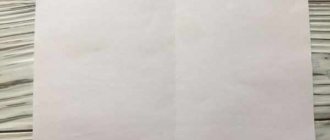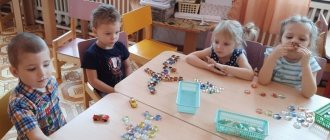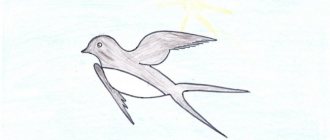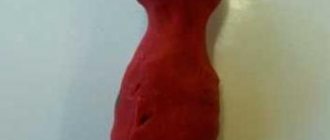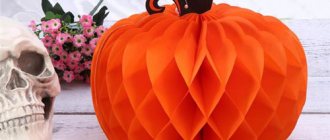Summary of a drawing lesson on the topic: Motherland. Preparatory group
Summary of plot drawing on the theme of the quest - travel “Native Country” in the preparatory group
Goal : to educate children with moral and patriotic feelings for the region where they live, for their small Motherland. Objectives: Educational:
- to consolidate students’ ideas about their native land, about the big and small homeland, that for every person the small homeland is the place where he was born, where he lives;
- develop the ability to construct sentences correctly, pay attention to the use of pronouns: mine, mine, ours; — teach children to convey the characteristic features of nature in drawings, reflect their impressions, and consolidate compositional skills. Developmental:
- develop a sense of responsibility and pride for the achievements of the country, native land;
- develop aesthetic and emotional feelings when perceiving artistic words, phonetic perception, logical thinking, imagination, memory, speech with movement; - develop speech as a means of communication, the ability to maintain a casual conversation, answering the teacher’s questions; activate and enrich vocabulary on the topic, introduce the words “small Motherland”, “big Motherland”, names of cities into the passive dictionary; -to develop students’ attention, imagination, and horizons. Educational:
- to cultivate patriotic feelings, love for the Motherland, for the region, for nature;
a feeling of kindness, belonging and empathy for everything living and beautiful that surrounds us through a friendly attitude towards peers, a willingness to communicate. Integration of educational areas: cognitive development, socio-communicative development, speech development, physical development, artistic and aesthetic development. Types of activities : gaming, communicative, cognitive-research, motor, artistic and aesthetic; use of the game situation throughout the entire joint activity. Vocabulary work: Donbass, Donetsk People's Republic, symbols, minerals Individual work: Helping students who have difficulty choosing and describing the sign of a mineral, clarifying and formulating an answer to the question posed. Methods and techniques: visual, verbal, game, reflection, encouragement, logical reasoning, vocabulary activation, question-answer, conversation. Venue: group room. Preliminary work: - conversations: “Our Motherland Donetsk Region”, “Symbols of the Donetsk People’s Republic and the city of Donetsk”; - reading fiction (A. A. Mytarev, L. M. Savelyeva “Our Native Land”, poems about Donbass, Donetsk); - examining illustrations, maps, learning poems about their native land, didactic games, puzzles, excursions; - creation of educational activities in the group - a game situation, group work, conversation, story, reading poems. - dynamic exercises - speech with movement. -listening to music. Technical means: Music center.
Progress of the lesson
Educator : Guys, look what a wonderful day it is today, the sun is smiling at us, let’s share our good mood with everyone and say hello to our native land and guests. Hello golden sun! Hello blue sky! Hello free breeze! Hello little oak tree! We live in our native land! We welcome you all! Show me your palms, and now rub them together. What do you feel? Now let's put our palms together and transfer warmth to each other. You are very friendly and affectionate guys, and only such people live in our city. Educator: What do we call Motherland? The house where you and I live And the birches along the road along which we walk What do we call Motherland? The sun in the blue sky and fragrant, golden Bread at the festive table. What do we call Motherland? The land where you and I live. Educator: Guys, what are we going to talk about today? That's right, we will talk about the Motherland. — Guys, what is “small Motherland”? (city, house where we live) Educator: That's right, well done, our small Motherland is our city, where we were born, live and grow, where our relatives live: mom, dad, brothers and sisters, our kindergarten. Educator : Guys, what is the “big Motherland”? Children : The Big Motherland is our Donetsk region. To the music (“The dark mounds are sleeping”) the Dwarf Shakhtarik enters. Gnome : Hello, dear guys! You recognized me? I am a dwarf Shakhtarik. Where do you think I live? (answers). It’s true that I live underground, but sometimes I go to the surface to see how people live. I want to know more about your region and the city in which you live. I have prepared a gift for you - this is a chest. But I don’t give anything to anyone just like that; I suggest you go on a quest trip. You need to pass several tests and then you will receive the key, open the chest and find my gift. (The Shakhtarik Gnome gives the box and leaves). Low mobility game “Catch the ball, don’t yawn, answer the questions” Blitz poll: - What is the name of our young republic? - Name the head of the republic? (Pushilin Denis Vladimirovich) - Name the city in which you live? — What was the name of your city before? — What are state symbols? (coat of arms, flag, anthem) - What is depicted on the coat of arms of the DPR? (a white double-headed eagle, on whose chest a white figure of St. Archangel Michael is depicted in a red shield.) - What are the colors on the DPR flag and what do they mean? (The black color symbolizes the fertile land of New Russia and the coal of Donbass. The blue color symbolizes the spirit of the people and the waters of the Azov Sea. The red color symbolizes the blood shed for the freedom of the people.) - Which river flows? — Where does the Kalmius River flow? Educator: Well done guys, get the first clue (gives a rose). What does this mean guys? What does rose mean? (rose symbol of Donetsk). I suggest you collect a “Bouquet of Beautiful Words” from roses. Each of you says one beautiful word about our city and puts a rose in a vase (modern, hardworking, charismatic, fragrant, dear, beloved, hospitable, warm, kind, green, etc.) Educator: This is what a beautiful bouquet we are collected. Well done, you passed the test and for this you get a second hint. Look what I found in the box - a treasure. (shows a piece of coal). Our region contains many real treasures. Tell me, what are these treasures and what are they for? (Children's answers). Didactic game “Minerals” Educator: What a great fellow you are, guys. How much do you know about our region? Before starting the next test, I suggest you take a little rest. Physical exercise “Motherland” In the morning we get up early, (raise your arms up and lower them to the sides) We see the city outside the window. (point with hands to the window) He woke up, he is alive, (hands on his belt, springs in both directions) He is calling us to the street. (walking in place) Houses are different: High and low, (raise your arms up and lower them) Distant and close, (extend your arms and bring them closer to you) Wooden, panel, brick, (move with one hand, as if counting) It seems ordinary. (spread hands) We live, we grow in our native city. (gradually rise on your toes with your arms raised and take the position.) For someone - small - (show a small object with your hands) But for us - huge. (raise your arms up and lower them to your sides). Educator: Have a rest! Here's the next hint. (Shows a model of a waste heap). What is this? Children: waste heaps. Educator : Probably, the Gnome wants us to talk about the sights of our city. Children : (Circus, water park, Shcherbakov Park, theaters, museums, railway station, Krupskaya library) Educator : Well done, we completed the task. Oh, look - I found the key to the chest (they open the chest and find paints and a brush). Probably, the Gnome wants us to draw our city, because he doesn’t have a camera to take a picture. Educator : Before completing this task, what should you visit to see how modern artists depict our city? Children: we must visit the art museum. Educator : Let's go there as soon as possible. (children approach the paintings and look at them). You can depict some of your favorite places in the city, where you like to go with your parents. Educator: Artists use different materials and drawing techniques to paint pictures. Today we will also use unconventional techniques - painting on glass, poking and painting with lush colors. Take your seats and get to work. (Children sit at the tables and begin to draw) Educator: Guys, you need to rest a little. Where is the best place to relax? Children: outdoors, in the botanical garden. Educator: Let's go with you to the botanical garden. (children sit in a clearing) Relaxation “In a forest clearing” Educator: Now, imagine that you are in a forest clearing. You are sitting on soft fragrant grass. Beautiful, fragrant flowers grow around you, and bees buzz above them and beautiful butterflies fly. Let's breathe in the scent of flowers. (The students, together with the teacher, perform a breathing exercise: they take a calm breath through the nose, hold their breath and exhale for a long time, saying “Ah - ah!”) Educator : We rested a little and now we return to our work. (At the end of the lesson, the children tell what they drew.) Educator : You turned out to be very beautiful works. The gnome will be very pleased with such a gift. Educator : I would like to finish our lesson with beautiful words: Children read poems 1. Donetsk land, beloved land, Beautiful, boundless land, The expanse of your fields has been dear to me since childhood, There is no such other land anywhere in the world! 2. Donetsk residents can cope with any task. Our Donetsk coal is famous everywhere. You give me strength and inspiration. So may your blossoms be more magnificent!
We recommend watching:
Summary of a drawing lesson in the preparatory group “The Rooks have Arrived” Summary of a drawing lesson in a preparatory group for school on the topic: Winter Summary of GCD in the senior group of the kindergarten “Excursion to the city of Kataysk” Summary of a conversation in the preparatory group of a preschool educational institution. Bashkir national costume
Similar articles:
Conversation “Big and Small Motherland” in the preparatory group
On the topic: methodological developments, presentations and notes
Enriching specific ideas about the state structure of Russia, significant historical events, achievements, and victories of Russia in the past and present is the basis and condition for development.
Experience of working with children of senior and preparatory school groups on the topic “Native Country” (2003-2004).
Planning on the topic » My city. Native country" Educators Tsyganova T.I. Plaksa T.N.
Creation of a system of work on patriotic education through familiarization with the native country.
Preparatory group for school.
The material provides an example of long-term planning for the topics “Family”, “Kindergarten”, “self-image”, “Native country”.
Expand ideas about Russia - as the country in which we live.
Source
Progress of the lesson.
— I’m glad to see all the children in our group healthy and cheerful! I really want you to remain in this mood until the evening! And for this we must smile more often and help each other! After all, every smile is a little sun that makes you feel warm and good.
-Dear guys, I want to invite you on an exciting journey through the corners of our Motherland.
Try to answer the question:
-What is the Motherland, native land? Why do you love her? (Children's answers)
The homeland is, first of all, the closest people - mother, father, grandmother, grandfather. This is your home, street, village where you were born and live. This is the kindergarten where you go, the teachers who surround you.
(Children show drawings about their native land, about nature, drawn together with their parents).
1st child: What do we call Motherland?
The house where you and I live,
And the birch trees along which
We walk next to mom.
Performance of "Song of the Motherland"
music V. Jelinek, lyrics. E. Karaseva.
— Guys, what is the name of our city? (Abakan)
2nd child: My Abakan! My capital!
My wonderful, dear city!
Nothing compares to you
I'm glad to see this city!
And today we will go on a trip by bus to the museum.
-Shall we begin our journey? But how do we get into the city? What can you go on a trip with? Let's go by bus. Using a counting rhyme, we will choose a driver.
Children take their seats on the bus and sing the song “Merry Travelers”
music M. Starokadomsky, lyrics. S. Mikhalkov hit the road. The children get off the bus.
-Here comes the museum, please. Go to the display case.
— Tell me, who is the most important person in our country? (The president)
-What do you think is his main task, what should he do first of all?
(So that in our country all peoples: Russians and Khakassians, and other nations live peacefully and amicably, work together)
— What is the name of the country in which we live? ( Russia )
- Name the capital of our homeland.
3rd child: I love you, Russia ,
I love you Moscow!
You, Moscow, are loved by everyone,
We all need you, Moscow.
— I want to tell you about Red Square. Here is the Kremlin, where the chimes are located, by which the whole country checks time, St. Basil's Cathedral, a monument to Minin and Pozharsky. It turns out that Red Square was first called Torg, since trade was carried out there. Currently, military parades and demonstrations are taking place on Red Square. Russian flag proudly flutters .
Showing the children the flag of the Russian Federation
Russian flag consists of three stripes of equal width. What do the colors on the flag mean?
4th child: White color – birch,
Red stripe – solar dawn.
— In Russia, these colors have been revered for a long time, and had their own symbolic knowledge: white - nobility, blue - honesty, red - courage and generosity.
Where else can we meet the Russian ?
(On ships, in the hands of athletes, soldiers)
- Let's play the game “Make the flag correctly”,
.
Two children participate in the game. Russian flag from strips of colored paper . The speed and correctness of completing the task is assessed.
— In addition to the flag, Russia also has its own coat of arms . (Children look at the coat of arms of Russia )
5th child: Russia has great
The coat of arms has a double-headed eagle,
So that to the west, to the east
He could have looked right away.
He is strong, wise and proud,
He is Russia's free spirit .
— The coat of arms of Russia is a dark red shield with a golden double-headed eagle on it. The coat of arms of Moscow is placed on the eagle's chest; it also has the shape of a shield. This means that Moscow is the capital of the powerful Russian state .
Where can you see the image of the coat of arms of Russia ?
(On documents and coins, children look at them)
- Guys, now we’ll take a little break and have a little physical education:
Zhura - zura - crane!
He flew over a hundred lands.
Wings, legs strained.
We asked the crane:
Where is the best land?
There is no better native land!
-Each state has its own anthem. This is the main song of the state, which is performed on special occasions. When the anthem is played, everyone stands up and men take off their hats.
(Children listen to an audio recording of the Russian )
— Our journey ends, we return to our beloved kindergarten by bus.
(Children get on the bus and arrive at kindergarten)
-There are many different states on our planet. Every person is a citizen of one country or another, is proud of his homeland, loves it.
And although you are still small children, you are already citizens.
But the most important task of all people on earth is to remember that there are many countries in the world, but we have one home, a common one, which is called planet Earth. We should all live here as good friends, respecting the traditions, culture, and customs of different countries and peoples.
-And now we will draw and color the Russian flag . Please come to the table and choose your favorite picture.
Determine what work each child will do (color with colored pencils, paints, cotton swabs or felt-tip pens)
On the topic: methodological developments, presentations and notes
The purpose of the lesson is to teach children to draw a giraffe using simple geometric shapes. Improve technical drawing skills using familiar image techniques, draw in a certain point.
Drawing project "Journey to the Land of Colors" junior preschool age.
Summary of joint educational activities with children of the senior drawing group “Journey to the Country of Fine Arts.”
During NOD, students become familiar with non-traditional drawing techniques.
Drawing with non-traditional techniques opens up wide scope for children's imagination. Paint only with a brush? But it's boring! I present an entertaining open event for preparatory activities.
Learning to draw fairy-tale characters using artistic expression.
Consultation for parents. "JOURNEY TO THE COUNTRY OF DRAWING."
Source


